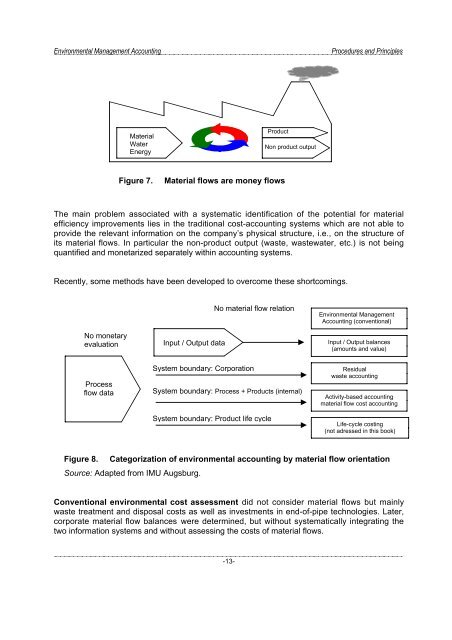Environmental Management Accounting Procedures and Principles
Environmental Management Accounting Procedures and Principles
Environmental Management Accounting Procedures and Principles
Create successful ePaper yourself
Turn your PDF publications into a flip-book with our unique Google optimized e-Paper software.
<strong>Environmental</strong> <strong>Management</strong> <strong>Accounting</strong><br />
<strong>Procedures</strong> <strong>and</strong> <strong>Principles</strong><br />
Material<br />
Water<br />
Energy<br />
Product<br />
Non product output<br />
Figure 7.<br />
Material flows are money flows<br />
The main problem associated with a systematic identification of the potential for material<br />
efficiency improvements lies in the traditional cost-accounting systems which are not able to<br />
provide the relevant information on the company’s physical structure, i.e., on the structure of<br />
its material flows. In particular the non-product output (waste, wastewater, etc.) is not being<br />
quantified <strong>and</strong> monetarized separately within accounting systems.<br />
Recently, some methods have been developed to overcome these shortcomings.<br />
No monetary<br />
evaluation<br />
Input / Output data<br />
No material flow relation<br />
<strong>Environmental</strong> <strong>Management</strong><br />
<strong>Accounting</strong> (conventional)<br />
Input / Output balances<br />
(amounts <strong>and</strong> value)<br />
Process<br />
flow data<br />
System boundary: Corporation<br />
System boundary: Process + Products (internal)<br />
System boundary: Product life cycle<br />
Residual<br />
waste accounting<br />
Activity-based accounting<br />
material flow cost accounting<br />
Life-cycle costing<br />
(not adressed in this book)<br />
Figure 8. Categorization of environmental accounting by material flow orientation<br />
Source: Adapted from IMU Augsburg.<br />
Conventional environmental cost assessment did not consider material flows but mainly<br />
waste treatment <strong>and</strong> disposal costs as well as investments in end-of-pipe technologies. Later,<br />
corporate material flow balances were determined, but without systematically integrating the<br />
two information systems <strong>and</strong> without assessing the costs of material flows.<br />
-13-




